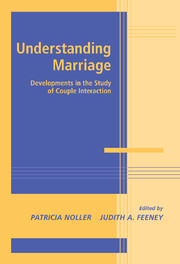Book contents
- Frontmatter
- Contents
- Contribitors
- Introduction
- SECTION ONE THE EFFECT OF COGNITION ON INTERACTION PATTERNS
- SECTION TWO UNDERSTANDING THE IMPORTANCE OF POSITIVE INTERACTION
- SECTION THREE COPING WITH DISAPPOINTMENT, CRITICISM, AND BETRAYAL
- SECTION FOUR POWER, CONFLICT, AND VIOLENCE IN MARITAL INTERACTION
- Marital interaction at important transition periods
- Introduction to Section Five
- 14 Adult Attachment, the Transition to Parenthood, and Marital Well-Being
- 15 Allocation and Performance of Household Tasks: A Comparison of New Parents and Childless Couples
- 16 Care Giving and Its Influence on Marital Interactions between Older Spouses
- SECTION SIX Interventions for strengthening relationships
- Conclusions
- Index
- References
14 - Adult Attachment, the Transition to Parenthood, and Marital Well-Being
Published online by Cambridge University Press: 25 July 2009
- Frontmatter
- Contents
- Contribitors
- Introduction
- SECTION ONE THE EFFECT OF COGNITION ON INTERACTION PATTERNS
- SECTION TWO UNDERSTANDING THE IMPORTANCE OF POSITIVE INTERACTION
- SECTION THREE COPING WITH DISAPPOINTMENT, CRITICISM, AND BETRAYAL
- SECTION FOUR POWER, CONFLICT, AND VIOLENCE IN MARITAL INTERACTION
- Marital interaction at important transition periods
- Introduction to Section Five
- 14 Adult Attachment, the Transition to Parenthood, and Marital Well-Being
- 15 Allocation and Performance of Household Tasks: A Comparison of New Parents and Childless Couples
- 16 Care Giving and Its Influence on Marital Interactions between Older Spouses
- SECTION SIX Interventions for strengthening relationships
- Conclusions
- Index
- References
Summary
The transition to parenthood is one of the most stressful and life-altering events that many people ever face (Belsky & Pensky, 1988). Compared to other life transitions, it is unique in that most people experience it (United States Department of Census, 2000), its onset is typically known and often planned, and it involves a fairly uniform sequence of stages and experiences through which most people pass. For many couples, having a child is associated with declines in marital quality over time (Belsky, 1985 Cowan, Cowan, Core, & Core, 1978). However, variation in marital quality also increases across the transition period (Tucker & Aron, 1993), suggesting that while some couples experience decrements in marital well-being, some show improvements. Which couples fare well and which ones fare poorly, and what is happening in their marriages across the transition period?
In this chapter, we address these questions by applying principles from attachment theory (Bowlby, 1969; 1973; 1980). After reviewing prior research and models of the variables that predict changes in marital well-being across the transition to parenthood, we discuss how attachment theory sheds light on which individuals in which marriages should be more versus less susceptible to experiencing downturns in marriage. We propose that attachment security should serve as an “inner resource” (1998) that allows secure people to cope with the trials and tribulations of new parenthood more effectively, buffering them from downturns in marriage.
- Type
- Chapter
- Information
- Understanding MarriageDevelopments in the Study of Couple Interaction, pp. 385 - 410Publisher: Cambridge University PressPrint publication year: 2002
References
- 14
- Cited by



